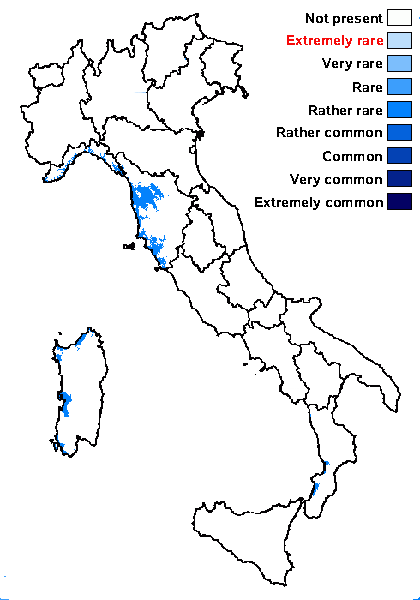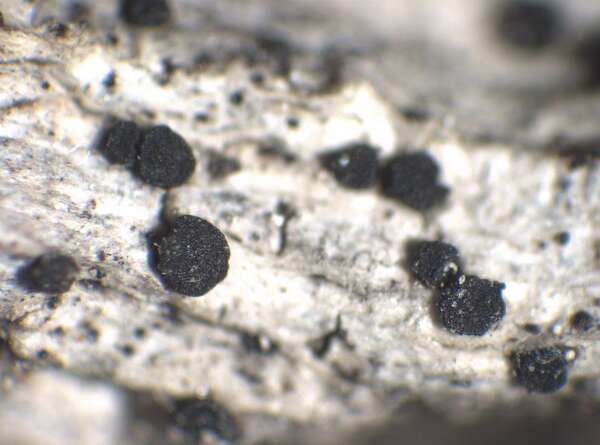Bactrospora patellarioides var. doriae (Bagl.) ined.
. Basionym: Raphiospora doriae Bagl. - Comm. Soc. Crittog. Ital., 1, 1: 20, 1861.
Synonyms: Bactrospora patellarioides var. convexa (B. de Lesd.) Egea & Torrente; Lecanactis patellarioides var. convexa B. de Lesd.
Distribution: N - Lig (Watson 2014). C - Tosc (Loppi & al. 1997c, 1999a, 2004c, Putortì & Loppi 1999, Senese & Critelli 2000), Sar (Jatta 1909-1911). S - Pugl (Nimis & Tretiach 1999), Cal (Puntillo 1996).
Description: Thallus crustose, episubstratic, continuous to rimose, white, creamy white or pale brownish grey, smooth to farinose, ecorticate, with a thick epinecral layer filled with crystals, sometimes delimited by a thin dark prothallus. Apothecia lecideine, black, adnate, usually not constricted at base, round to slightly irregular in outline, 0.2-0.4(-0.6) mm across, with a flat to usually convex, epruinose disc, and a thin, smooth, soon excluded proper margin. Proper exciple dark orange brown to dark brown, usually extending below the hymenium (rarely open), up to 80 µm thick at base; epithecium dark reddish brown, granulose, I+ blue; hymenium colourless to pale brown, (65-)110-170 µm high, I+ pale red, K/I+ pale blue; paraphysoids richly branched and anastomosing in upper part, not coherent, c. 1.5 µm thick at base, the apical cells up to 4 µm wide; subhymenium pale to dark brown, I+ reddish or deep blue, K/I+ deep blue. Asci (6-)8-spored, narrowly clavate to cylindrical, with a distinct stipe and foot-like base, easily separated from the ascogenous hyphae, bitunicate-fissitunicate, with a narrow, K/I+ pale blue apex, with an apical dome penetrated by a small ocular chamber surrounded at the base by a small K/I+ dark blue ring-like zone, the exoascus thin and refringent, the endoascus slightly hemiamyloid, (80-)90-135 x 11-13(-14) µm. Ascospores 9-17(-25)-septate, acicular or cylindrical, straight or slightly curved, (42-)60-120 x 2-3.5(-5) µm. Pycnidia semi-immersed, the wall brown in upper part, colourless at base. Conidia cylindrical, slightly curved, 13-17 x c. 1 µm. Photobiont trentepohlioid. Spot tests: thallus K-, KC-, C-, P-, UV-. Chemistry: without lichen substances.Note: most frequent in Tyrrhenian Italy, especially on Olea.
Growth form: Crustose
Substrata: bark
Photobiont: Trentepohlia
Reproductive strategy: mainly sexual
Most common in areas with a humid-warm climate (e.g. most of Tyrrenian Italy)
In underhangs rarely wetted by rain
Commonnes-rarity: (info)
Alpine belt: absent
Subalpine belt: absent
Oromediterranean belt: absent
Montane belt: absent
Submediterranean belt: absent
Padanian area: absent
Humid submediterranean belt: absent
Humid mediterranean belt: rather rare
Dry mediterranean belt: absent

Predictive model
Herbarium samples
Growth form: Crustose
Substrata: bark
Photobiont: Trentepohlia
Reproductive strategy: mainly sexual
Most common in areas with a humid-warm climate (e.g. most of Tyrrenian Italy)
In underhangs rarely wetted by rain
Commonnes-rarity: (info)
Alpine belt: absent
Subalpine belt: absent
Oromediterranean belt: absent
Montane belt: absent
Submediterranean belt: absent
Padanian area: absent
Humid submediterranean belt: absent
Humid mediterranean belt: rather rare
Dry mediterranean belt: absent

Predictive model
| Herbarium samples |



